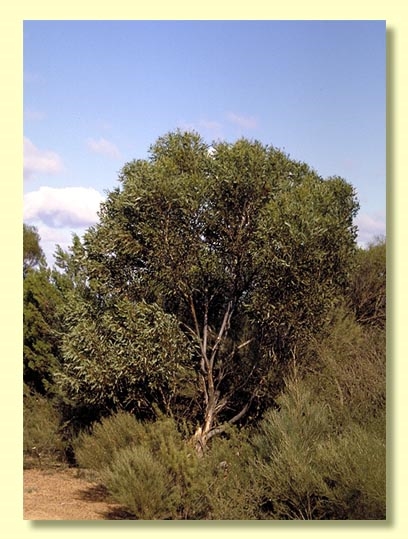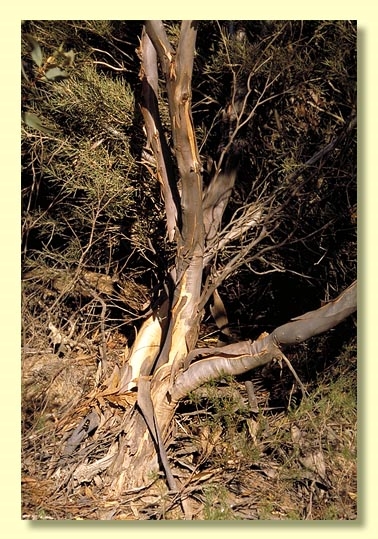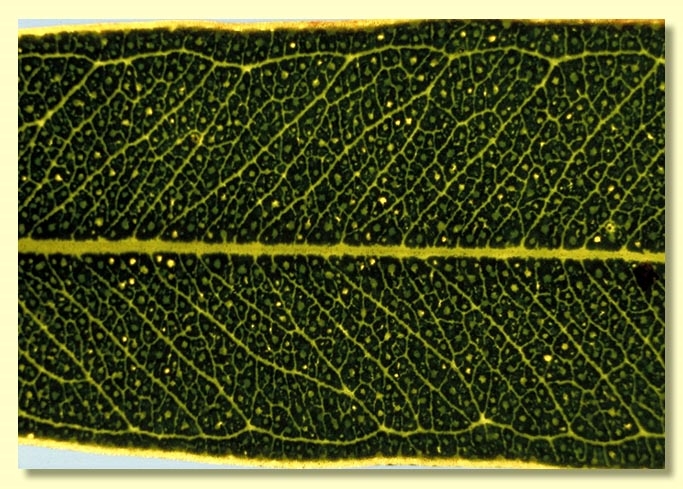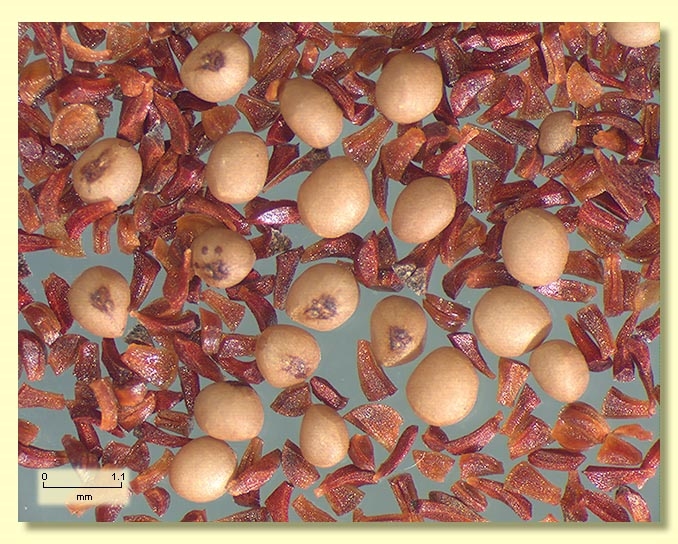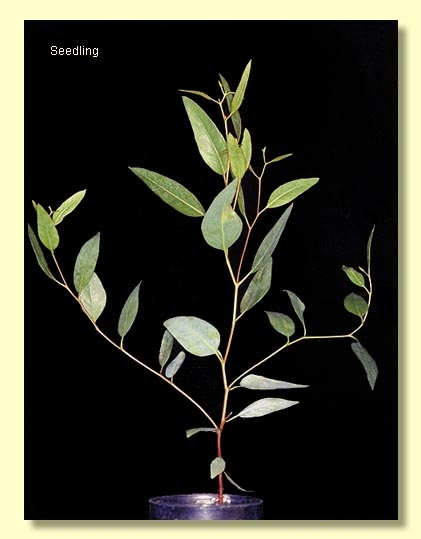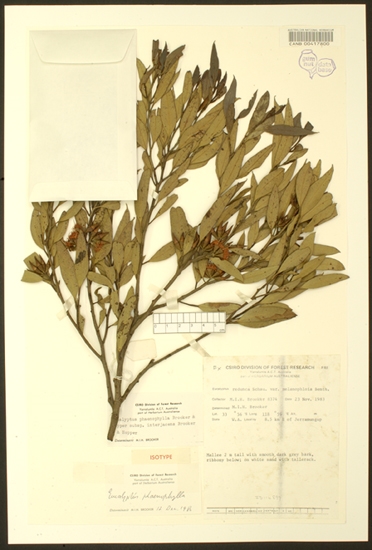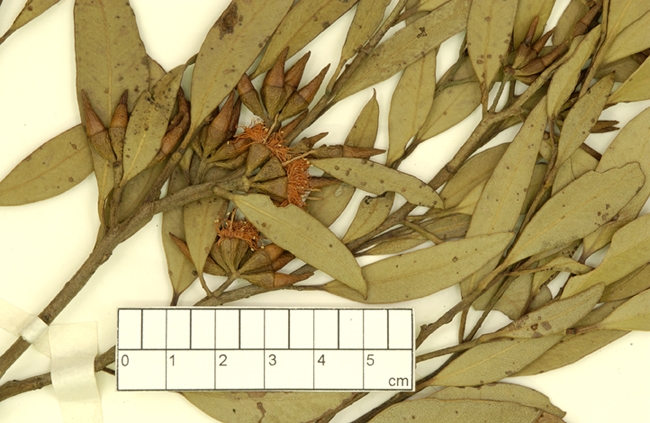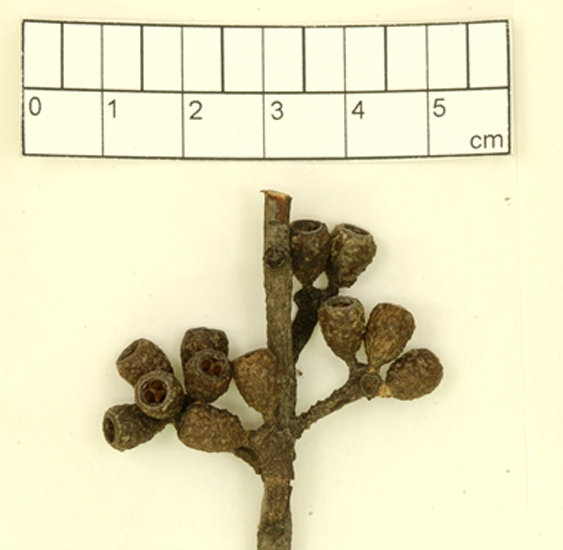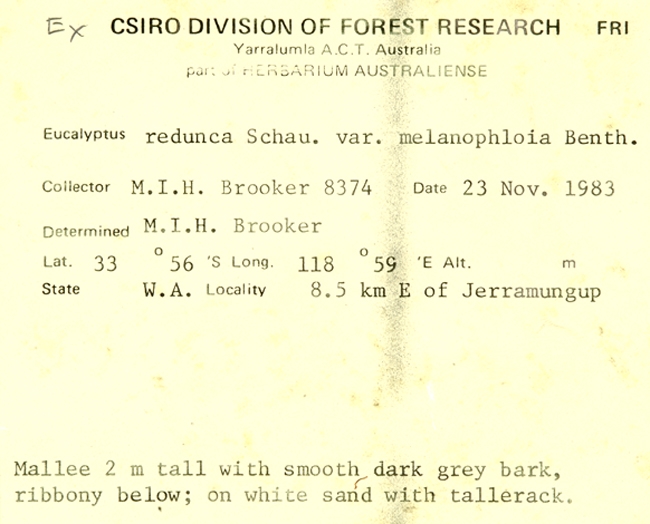Eucalyptus | Symphyomyrtus | Bisectae | Glandulosae | Levispermae | Phaenophylla
Euclid - Online edition
Eucalyptus phaenophylla subsp. interjacens
Classification
Nomenclature
Description
Mallee to 5 m tall. Forming a lignotuber.
Bark smooth throughout, grey to brown and brown-orange.
Branchlets have oil glands in the pith, or sometimes these are obscure or only a few at the nodes.
Juvenile growth (coppice or field seedlings to 50 cm): not seen.
Adult leaves alternate, petiole 0.8–1.8; blade narrowly lanceolate or elliptical, 4.3–8 cm long, 0.8–2 cm wide, base tapering to petiole, apex pointed, margin entire, concolorous, glossy, green, side-veins usually greater than 45° to midrib, reticulation moderate to dense, intramarginal vein remote from margin, oil glands mostly intersectional.
Inflorescence axillary unbranched, peduncles widening apically, 1–2 cm long, buds ?11 or 13, pedicellate (pedicels 0.2–0.4 cm long). Mature buds elongated and fusiform (1.2–1.8 cm long, 0.3–0.5 cm wide), scar present, operculum horn-shaped, 2 to 3 times as long as the hypanthium and more or less equalling the width at the join, some outer stamens erect or with filament erect and anther deflexed, inner stamens deflexed to varying degrees, anthers oblong, versatile, dorsifixed, dehiscing by longitudinal slits, style long, straight, stigma ± rounded, locules 3, the placentae each with 4 vertical rows of ovules. Flowers pale lemon to cream.
Fruit pedicellate (0.1–0.4 cm long), usually barrel-shaped to cylindrical or sometimes obconical, 0.6–0.9 cm long, 0.5–0.7 cm wide, disc descending, valves 3, at rim level.
Seeds pale straw-coloured, 0.8–2 mm long, sub-spherical, surface smooth, hilum terminal.
Cultivated seedlings (measured at node 10): cotyledons Y-shaped (bisected); stems rounded (or ?triangular) in cross-section, smooth to slightly warty; leaves always petiolate, opposite for 3 to 5 nodes then alternate, lanceolate to ovate, 5.5–10 cm long, 2–4.5 cm wide, dull green becoming glossy.
Bark smooth throughout, grey to brown and brown-orange.
Branchlets have oil glands in the pith, or sometimes these are obscure or only a few at the nodes.
Juvenile growth (coppice or field seedlings to 50 cm): not seen.
Adult leaves alternate, petiole 0.8–1.8; blade narrowly lanceolate or elliptical, 4.3–8 cm long, 0.8–2 cm wide, base tapering to petiole, apex pointed, margin entire, concolorous, glossy, green, side-veins usually greater than 45° to midrib, reticulation moderate to dense, intramarginal vein remote from margin, oil glands mostly intersectional.
Inflorescence axillary unbranched, peduncles widening apically, 1–2 cm long, buds ?11 or 13, pedicellate (pedicels 0.2–0.4 cm long). Mature buds elongated and fusiform (1.2–1.8 cm long, 0.3–0.5 cm wide), scar present, operculum horn-shaped, 2 to 3 times as long as the hypanthium and more or less equalling the width at the join, some outer stamens erect or with filament erect and anther deflexed, inner stamens deflexed to varying degrees, anthers oblong, versatile, dorsifixed, dehiscing by longitudinal slits, style long, straight, stigma ± rounded, locules 3, the placentae each with 4 vertical rows of ovules. Flowers pale lemon to cream.
Fruit pedicellate (0.1–0.4 cm long), usually barrel-shaped to cylindrical or sometimes obconical, 0.6–0.9 cm long, 0.5–0.7 cm wide, disc descending, valves 3, at rim level.
Seeds pale straw-coloured, 0.8–2 mm long, sub-spherical, surface smooth, hilum terminal.
Cultivated seedlings (measured at node 10): cotyledons Y-shaped (bisected); stems rounded (or ?triangular) in cross-section, smooth to slightly warty; leaves always petiolate, opposite for 3 to 5 nodes then alternate, lanceolate to ovate, 5.5–10 cm long, 2–4.5 cm wide, dull green becoming glossy.
Flowering Time
Flowering has been recorded in January, February, March, April, August, September, October, November and December.
Notes
Eucalyptus phaenophylla is a species of mallee habit endemic to Western Australia, occurring from Wickepin to the Ravensthorpe Range. The stems are smooth and the adult leaves glossy green. The opercula are long and narrower than the hypanthium at the join.
Eucalyptus phaenophylla belongs to Eucalyptus subgenus Symphyomyrtus section Bisectae subsection Glandulosae because the cotyledons are bisected, buds have an operculum scar and the branchlets have oil glands in the pith. Within this subsection E. phaenophylla is one of a group of species that form series Levispermae subseries Phaenophylla characterised by having smooth sub-spherical seed, a peduncle that widens apically, buds that are narrowly fusiform with some stamens erect and others variably deflexed, and glossy green leaves.
E. phaenophylla is distinguished from other species with narrowly fusiform buds by the combination of glossy green adult leaves, smooth bark and bud length (to 1.8 cm). Its closest relatives are E. arachnaea, which differs in having rough bark, opercula with recurved tips and a more northerly distribution; E. tumida, which has buds that are longer (to 2 cm long) and slightly fatter, slightly larger adult leaves, and occurs on low rises east of Ravensthorpe towards Scadden and east to Mt Ragged; E. luteola, which has tapering buds to 2 cm long, some scruffy semi-persistent bark on the trunk, leaves only slightly glossy and occurs on sand in the Hyden Scrub south to near Ravensthorpe; E. histophylla, with dull, erect leaves becoming glossy with age, smooth bark and long slender tapering buds to 2 cm, and distribution west of Balladonia associated with granite outcrops. Another related species, E. hebetifolia from the Harrismith-Cranbrook area south-east of Perth, differs mainly in having slightly smaller buds with the operculum narrower than the hypanthium at the join and seeds that are more cuboid than sub-spherical.
There are two subspecies:
E. phaenophylla subsp. phaenophylla
This has opercula that are distinctly narrower than the hypanthium at the join. It occurs from Wickepin east to the Stirling Range and to east of Jerramungup extending into Fitzgerald River National Park. Habitat is undulating sites of calcareous or lateritic loam. E. arachnaea also has the operculum narrower than the hypanthium, like subsp. phaenophylla, but differs as outlined above. Eucalyptus sparsicoma, from the Chinocup and Tincurrin North area of southern Western Australia, is included here in synonymy as the differences, namely imperfectly decorticated ribbony rough bark, sparse narrow-leaved crown and buds with operculum narrower than the hypanthium, do not distinguish it from the locally common E. phaenophylla subsp. phaenophylla.
E. phaenophylla subsp. interjacens
In this form the opercula are more or less equal in width to the hypanthium and the buds and fruit more robust than in subsp. phaenophylla. It occurs from Jerramungup to the Ravensthorpe Range extending east towards the Cascades and Esperance. E. tumida, E. histophylla and E. luteola all have opercula more or less equal in width to the hypanthium at the join like E. phaenophylla subsp. interjacens, but differ as outlined above.
Eucalyptus phaenophylla belongs to Eucalyptus subgenus Symphyomyrtus section Bisectae subsection Glandulosae because the cotyledons are bisected, buds have an operculum scar and the branchlets have oil glands in the pith. Within this subsection E. phaenophylla is one of a group of species that form series Levispermae subseries Phaenophylla characterised by having smooth sub-spherical seed, a peduncle that widens apically, buds that are narrowly fusiform with some stamens erect and others variably deflexed, and glossy green leaves.
E. phaenophylla is distinguished from other species with narrowly fusiform buds by the combination of glossy green adult leaves, smooth bark and bud length (to 1.8 cm). Its closest relatives are E. arachnaea, which differs in having rough bark, opercula with recurved tips and a more northerly distribution; E. tumida, which has buds that are longer (to 2 cm long) and slightly fatter, slightly larger adult leaves, and occurs on low rises east of Ravensthorpe towards Scadden and east to Mt Ragged; E. luteola, which has tapering buds to 2 cm long, some scruffy semi-persistent bark on the trunk, leaves only slightly glossy and occurs on sand in the Hyden Scrub south to near Ravensthorpe; E. histophylla, with dull, erect leaves becoming glossy with age, smooth bark and long slender tapering buds to 2 cm, and distribution west of Balladonia associated with granite outcrops. Another related species, E. hebetifolia from the Harrismith-Cranbrook area south-east of Perth, differs mainly in having slightly smaller buds with the operculum narrower than the hypanthium at the join and seeds that are more cuboid than sub-spherical.
There are two subspecies:
E. phaenophylla subsp. phaenophylla
This has opercula that are distinctly narrower than the hypanthium at the join. It occurs from Wickepin east to the Stirling Range and to east of Jerramungup extending into Fitzgerald River National Park. Habitat is undulating sites of calcareous or lateritic loam. E. arachnaea also has the operculum narrower than the hypanthium, like subsp. phaenophylla, but differs as outlined above. Eucalyptus sparsicoma, from the Chinocup and Tincurrin North area of southern Western Australia, is included here in synonymy as the differences, namely imperfectly decorticated ribbony rough bark, sparse narrow-leaved crown and buds with operculum narrower than the hypanthium, do not distinguish it from the locally common E. phaenophylla subsp. phaenophylla.
E. phaenophylla subsp. interjacens
In this form the opercula are more or less equal in width to the hypanthium and the buds and fruit more robust than in subsp. phaenophylla. It occurs from Jerramungup to the Ravensthorpe Range extending east towards the Cascades and Esperance. E. tumida, E. histophylla and E. luteola all have opercula more or less equal in width to the hypanthium at the join like E. phaenophylla subsp. interjacens, but differ as outlined above.
Origin of Name
Eucalyptus phaenophylla: Greek phaeno-, shiny and phyllon, leaf.
subsp. interjacens: Latin interjacens, coming between, referring to its geographical and morphological position between E. phaenophylla subsp. phaenophylla and E. tumida.
subsp. interjacens: Latin interjacens, coming between, referring to its geographical and morphological position between E. phaenophylla subsp. phaenophylla and E. tumida.
Copyright © CANBR 2020, all rights reserved.

Web edition hosted at https://apps.lucidcentral.org/euclid
